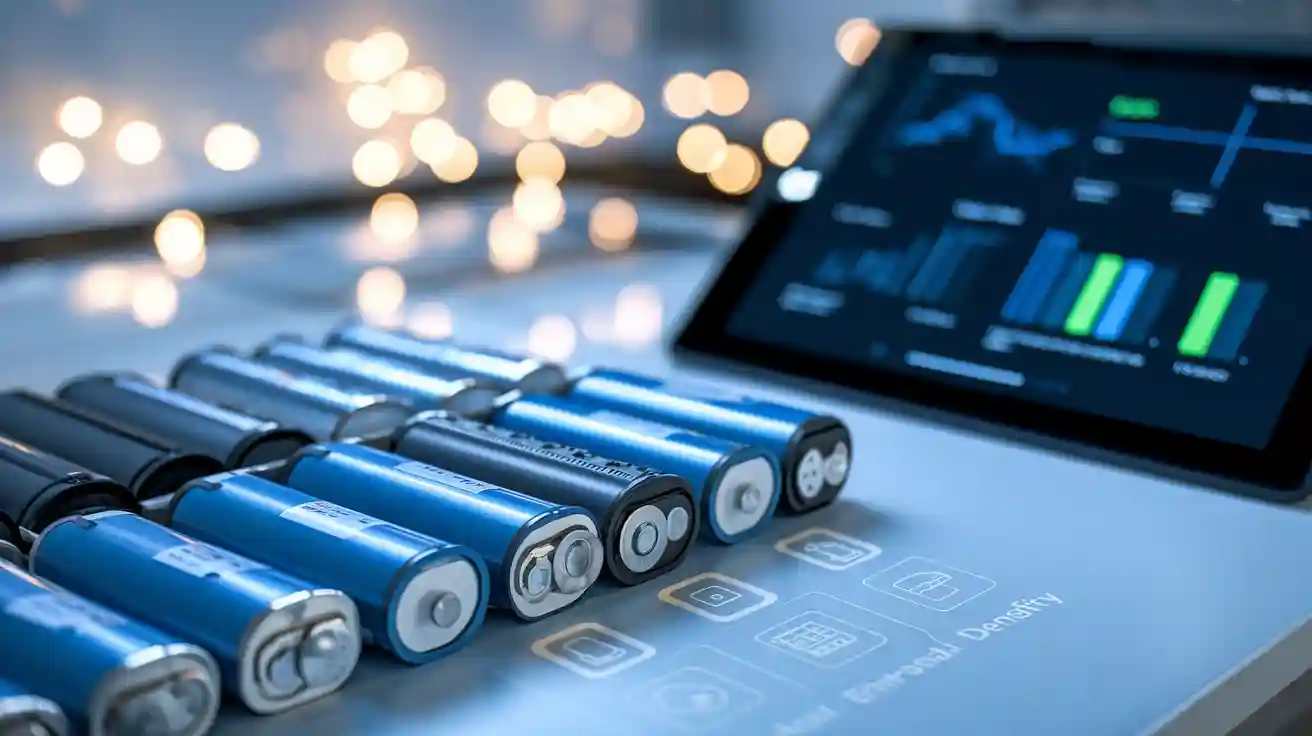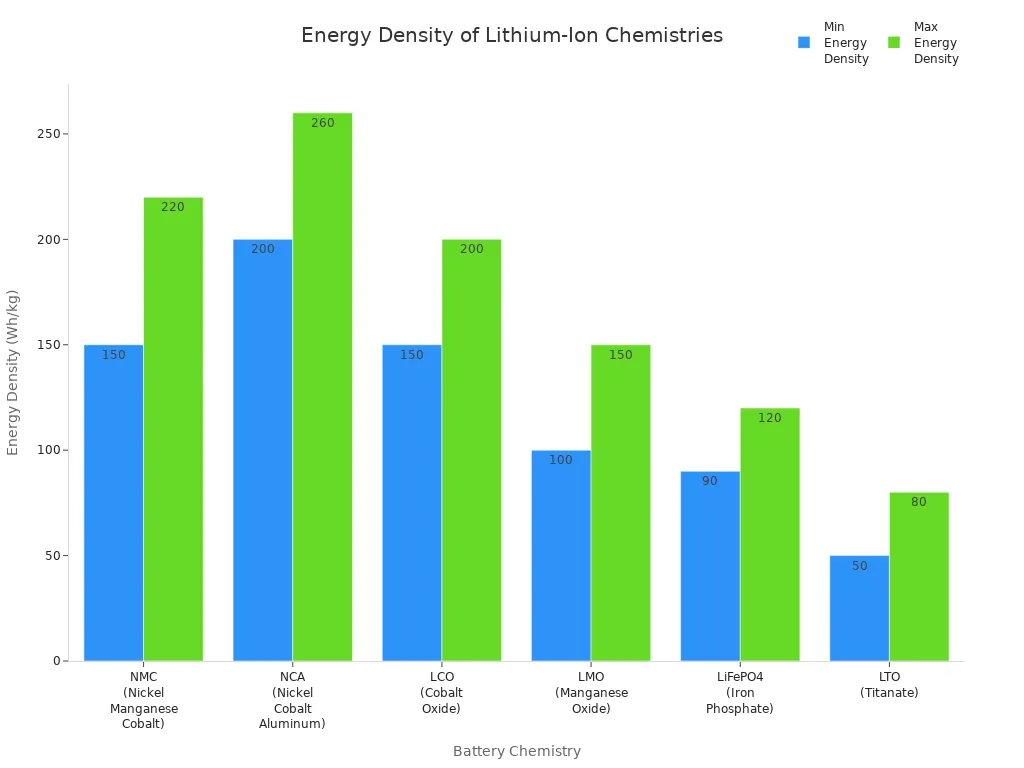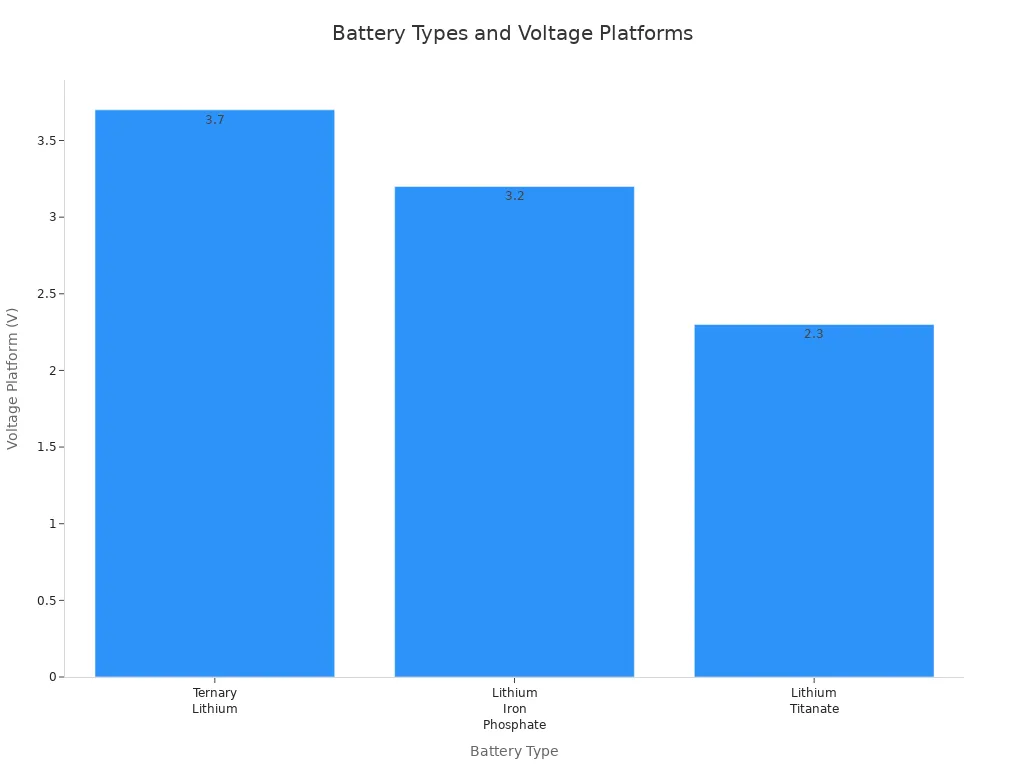
Ternary lithium batteries use a mix of nickel, cobalt, and manganese or aluminum salts as their main cathode materials. This combination gives these batteries high energy density and strong performance. Many people think all lithium batteries work the same, but ternary lithium batteries differ from LiFePO4 and LCO batteries in both chemistry and features. The table below highlights these differences:
| 电池类型 | Cathode Material Composition | Key Chemical Features |
|---|---|---|
| Ternary Lithium | Nickel, cobalt, manganese/aluminum salts | Synergy of multiple materials for balanced performance |
| LiFePO4 (LFP) | Lithium iron phosphate | Strong bonds, high safety, no cobalt |
| LCO | Lithium cobalt oxide | Single material, used in older batteries |
Understanding these distinctions helps prevent common misconceptions about battery safety, usage, and performance.
What Are Ternary Lithium Batteries?
Definition
A ternary lithium battery is a rechargeable battery that uses three main materials in its cathode: nickel salt, cobalt salt, and manganese salt. This unique mix sets it apart from other lithium batteries. The battery works by moving lithium ions between the cathode and anode through an electrolyte. When the battery charges, lithium ions travel from the cathode to the anode. During use, the ions move back, creating an electric current. This process allows the battery to store and release energy efficiently.
Industry experts agree that ternary lithium batteries stand out because of their high energy density, fast charging, and low self-discharge rates. These features make them a popular choice for many modern devices.
Ternary lithium batteries combine the strengths of nickel, cobalt, and manganese. Nickel boosts energy density, cobalt improves stability, and manganese increases safety. This balance helps the battery deliver strong performance in many situations. The ternary design also means the battery can last longer and charge faster than some other lithium batteries.
Importance
Ternary lithium batteries play a key role in today’s technology. Their high energy density lets electric vehicles travel farther on a single charge. This makes them a top choice for car makers who want to build better electric cars. The batteries also charge quickly, which saves time for users.
- Ternary lithium batteries help reduce the world’s need for fossil fuels. They support cleaner energy and help lower carbon emissions.
- Many governments now offer incentives for using green energy. This has led to more demand for electric vehicles and better batteries.
- Advances in battery chemistry have made ternary lithium batteries more powerful and affordable.
- The batteries also work well in renewable energy systems, such as solar and wind power storage.
Ternary lithium batteries have changed the way people use energy. They power not only electric vehicles but also many portable devices and large energy storage systems. As technology improves, these batteries will likely become even more important. The ternary mix in the battery’s cathode helps meet the growing need for safe, efficient, and long-lasting energy storage.
Ternary Lithium Battery Composition
Cathode Materials
The cathode in a ternary lithium battery uses a blend of nickel, cobalt, and manganese or sometimes aluminum. Each element plays a special role in the battery’s performance. Nickel increases the energy capacity, allowing the battery to store more power. Cobalt helps keep the layered structure stable and improves how well lithium ions move through the battery. Manganese makes the battery safer and helps it last longer. Aluminum, when present, adds extra strength and helps the battery handle heat better.
| Element | Role in Cathode of Ternary Lithium Battery |
|---|---|
| Nickel (Ni) | Raises energy capacity and specific capacity by supporting redox reactions at higher voltages. |
| Cobalt (Co) | Keeps the crystal structure stable and boosts ionic conductivity, helping the battery last longer. |
| Manganese (Mn) | Adds safety and thermal stability, making the battery more reliable over many cycles. |
| Aluminum (Al) | Improves thermal and structural stability, reducing risks and slowing down wear and tear. |
During charging and discharging, nickel and cobalt ions change their states, which helps move lithium ions in and out of the cathode. Manganese mostly stays the same, keeping the structure strong. Aluminum, if used, helps the battery resist heat and damage.
Tip: The right mix of these elements gives a ternary lithium battery its high energy, safety, and long life.
Working Principle
A ternary lithium battery works by moving lithium ions between the cathode and the anode, which is usually made of graphite. When the battery charges, lithium ions travel from the cathode to the anode. When the battery discharges, the ions move back, creating electricity.
| 方面 | 详细信息 |
|---|---|
| Core Process | Lithium ions move between the ternary cathode and graphite anode during charge/discharge. |
| Operating Voltage | About 3.7 V per cell, higher than many other lithium batteries. |
| 能量密度 | 232–293 Wh/kg, much higher than LiFePO4 batteries. |
| Real-world Example | Tesla Model Y uses ternary lithium batteries for a range of over 440 km per charge. |
The higher voltage and special cathode mix let a ternary lithium battery store more energy in a smaller space. This makes the battery a top choice for electric vehicles and devices that need long runtimes. The battery’s design also helps it deliver steady power and recharge quickly.
Ternary Lithium Battery Performance
能量密度
Ternary lithium battery technology stands out for its impressive energy density. This feature means the battery can store a large amount of energy in a small and lightweight package. Engineers use a mix of nickel, cobalt, and manganese or aluminum in the cathode. This combination boosts both energy and density, making ternary lithium batteries ideal for electric vehicles and portable electronics.
"(《世界人权宣言》) energy density of ternary lithium batteries often ranges from 150 to 260 Wh/kg. This value is higher than most other lithium batteries. For example, lithium iron phosphate batteries usually reach only 90 to 120 Wh/kg. The table below shows how different lithium battery chemistries compare in terms of energy density:
| 电池化学 | Typical Energy Density Range (Wh/kg) |
|---|---|
| NMC (Lithium Nickel Manganese Cobalt Oxide) | 150 – 220 |
| NCA (Lithium Nickel Cobalt Aluminum Oxide) | 200 – 260 |
| LCO (Lithium Cobalt Oxide) | 150 – 200 |
| LMO (Lithium Manganese Oxide) | 100 – 150 |
| LiFePO4 (Lithium Iron Phosphate) | 90 – 120 |
| LTO (Lithium Titanate) | 50 – 80 |

Ternary lithium batteries deliver high energy density because of the synergy between the cathode materials. Nickel increases the capacity, cobalt stabilizes the structure, and manganese or aluminum improves safety. This balance allows the battery to provide more energy for longer periods. Devices powered by ternary lithium batteries can run longer without frequent recharging. This advantage supports the growing demand for high-performance electric vehicles and advanced electronics.
充电速度
Charging speed is another area where ternary lithium battery technology excels. These batteries can accept higher charging currents, which means they recharge faster than many other lithium batteries. The voltage platform of ternary lithium batteries can reach up to 4.2 V per cell. This high voltage supports greater energy transfer during charging.
Ternary lithium batteries maintain strong charging efficiency, especially at high currents above 100 Ah. In contrast, lithium iron phosphate batteries show a rapid drop in charging efficiency at these higher currents. This difference makes ternary lithium batteries a better choice for users who need quick charging times. For example, electric vehicle owners benefit from shorter charging stops, making daily use more convenient.
Note: Fast charging does not always mean reduced battery life. Recent advances in ternary lithium battery chemistry, such as surface modifications and improved synthesis methods, help maintain both charging speed and long-term performance.
The ability to charge quickly and efficiently gives ternary lithium batteries an edge in applications where time matters. Portable devices, power tools, and electric vehicles all benefit from this feature.
周期寿命
Cycle life measures how many times a battery can charge and discharge before its capacity drops to a set level, usually 70% or 80% of its original value. Ternary lithium battery cycle life depends on several factors, including usage patterns, temperature, and charging rates.
Under standard conditions, ternary lithium batteries typically last between 500 and 1000 cycles. This range is lower than lithium iron phosphate batteries, which can reach about 2000 cycles. The table below summarizes the cycle life of different battery types:
| 电池类型 | Cycle Life Range (cycles) |
|---|---|
| Ternary lithium battery | 500 – 1000 (at standard discharge rate, capacity at 80%) |
| Lithium iron phosphate (LFP) | ~2000 (capacity >80%) |
Cycle life can change based on how the battery is used. Shallow cycling, where the battery operates between 10% and 90% state of charge, can extend the cycle life to over 1000 cycles. High discharge rates and high temperatures can reduce the cycle life to less than 200 cycles. The chart below shows how different conditions affect the cycle life of ternary lithium batteries:

Recent technological advancements have improved the cycle life and discharge performance of ternary lithium batteries. Techniques such as compositional optimization, surface modifications, and interfacial engineering help increase both stability and capacity retention. These improvements support a longer cycle life and better discharge performance, making ternary lithium batteries more reliable for demanding applications.
Tip: Users can extend the cycle life of a ternary lithium battery by avoiding deep discharges and high temperatures.
Ternary lithium batteries offer a balance between high energy density, fast charging, and reasonable cycle life. This balance makes them a popular choice for electric vehicles, consumer electronics, and energy storage systems that require both high performance and long cycle life.
Advantages of Ternary Lithium Batteries
High Output
Ternary lithium batteries deliver high output because of their unique design and material choices. These batteries operate at a higher discharge platform voltage, about 3.7V, which is higher than many other lithium batteries. This higher voltage allows the battery to provide greater specific capacity and longer life. The battery can support devices that need strong and steady power.
Several factors help ternary batteries achieve high output:
- The electrolyte and diaphragm materials support fast movement of lithium ions.
- The type and size of active material particles affect how quickly the battery can release energy.
- Thinner electrodes lower resistance, which lets the battery discharge at higher currents.
Note: Thinner electrodes improve the rate at which the battery can deliver power, but they also reduce the total amount of active material. Engineers must balance output and capacity when designing ternary batteries.
These features make ternary lithium batteries a top choice for electric vehicles and devices that need bursts of high power. The battery’s ability to maintain high output supports longer driving ranges and better performance in demanding applications.
Versatility
Ternary lithium batteries show great versatility, which benefits both manufacturers and end-users. Manufacturers can use these batteries in many industries, such as consumer electronics, automotive, energy storage, aerospace, defense, and medical devices. This flexibility allows companies to reach more markets and create new products.
End-users also gain many advantages from the versatility of ternary batteries:
- Devices last longer between charges because of high energy density.
- Electric vehicles can travel farther on a single charge.
- Renewable energy systems store power more efficiently.
- Fast charging and smart charging technologies make using the battery more convenient.
- Lightweight design suits specialized uses in aerospace and medical fields.
Ternary lithium batteries support fast charging, which means users can get a full charge quickly. Smart charging features help manage temperature and predict charging needs, which extends battery life and improves safety. These qualities make ternary batteries reliable for people who need efficient and long-lasting power, such as travelers and professionals.
The adaptability of ternary lithium batteries drives innovation and growth in many sectors. Their ability to meet different power needs ensures they remain in high demand as technology advances.
Disadvantages and Safety
Safety Concerns
Ternary lithium batteries offer high performance, but they also bring important safety concerns. These batteries can face risks during both manufacturing and use. Manufacturing defects, such as impurities or metal particles like copper, can cause internal short circuits. These short circuits may lead to thermal runaway, which is a dangerous rise in temperature. When thermal runaway happens, the battery can release flammable gases, catch fire, or even explode.
- 常见的安全风险包括
- Internal short circuits from copper particles or other metal contaminants
- Rapid battery degradation due to impurities
- Thermal runaway incidents that can cause fires or explosions
Ternary lithium batteries, especially those with high nickel content, have higher energy density. This makes them more likely to overheat under extreme conditions. To improve safety, manufacturers use advanced battery management systems (BMS) that monitor temperature and charging. Proper ventilation and fire safety equipment are also important, especially in industrial settings.
Note: Lithium iron phosphate batteries are considered safer because they have better thermal stability and lower fire risk.
Detection and control of metal foreign matter during production are critical for battery safety. As the use of these batteries grows, the need for strict safety standards and regular monitoring increases to protect both people and the environment.
成本因素
Ternary lithium batteries cost more than many other lithium battery types. The main reason is the use of expensive raw materials like nickel and cobalt. These metals are scarce and require complex mining and processing. The manufacturing process for ternary batteries is also advanced and involves steps such as precursor customization, sintering, ion doping, and surface coating. Each step adds to the production cost.
- Key cost factors:
- Scarcity and high price of nickel and cobalt
- Complex and energy-intensive manufacturing steps
- Strict environmental controls and waste recycling needs due to pollution risks
| 电池类型 | Environmental Impact Summary |
|---|---|
| Ternary Lithium (NMC) | Contains cobalt and nickel, leading to higher environmental costs due to mining, processing, and recycling. |
| 磷酸铁锂 | Does not contain cobalt or nickel, resulting in lower toxicity and reduced environmental risks. |
Ternary lithium batteries also impact the environment more than lithium iron phosphate batteries. The mining and processing of nickel and cobalt can harm the environment and require careful waste management. Recycling methods for these batteries include physical, chemical, and direct recycling. Some new methods recover over 95% of valuable metals and keep good battery performance. However, recycling still faces challenges such as safety risks, high costs, and environmental impacts. Environmentally friendly recycling is important for reducing pollution and protecting the environment.
Governments around the world set strict rules for battery manufacturing and recycling. These rules help reduce pollution and encourage safer, more environmentally friendly battery production. As demand for electric vehicles grows, the need for better recycling and safer batteries will continue to rise.
Ternary Lithium Batteries vs. LiFePO4
Performance Comparison
Ternary lithium batteries and LiFePO4 batteries show clear differences in key areas. Ternary lithium batteries offer higher energy density, which means they store more energy in a smaller space. This feature makes them popular in electric vehicles that need long driving ranges. LiFePO4 batteries have lower energy density but provide a 更长的循环寿命. They can last through thousands of charge and discharge cycles, making them reliable for long-term use.
| Performance Metric | Ternary Lithium Battery | LiFePO4 Battery |
|---|---|---|
| 能量密度(Wh/kg) | 232-293 | ~150 |
| Cycle Life (cycles) | 800-1000 | 2000-6000 |
| Low Temp. Performance | >70% capacity at -20°C | ~60% capacity at -20°C |
| 充电速度 | Fast | 中度 |
Ternary lithium batteries also perform better at low temperatures and charge faster. LiFePO4 batteries, while slower to charge, maintain steady output over many years.
Safety and Lifespan
Safety remains a top concern for any battery. LiFePO4 batteries stand out for their excellent thermal stability and low risk of fire. Their chemical structure resists overheating, which makes them a safe choice for homes and commercial energy storage. Ternary lithium batteries need advanced management systems to control heat and prevent thermal runaway. They have improved safety compared to older lithium-ion batteries but still require careful handling.
Lifespan also differs. LiFePO4 batteries often last longer, with up to 6000 cycles in some cases. Ternary lithium batteries usually reach about 1000 cycles before losing capacity. This difference makes LiFePO4 batteries a better fit for applications that demand long-term reliability.
Cost Differences
Cost plays a big role in choosing a battery. LiFePO4 batteries use iron and phosphate, which are common and inexpensive. This lowers both the cell price and the cost per kilowatt-hour. Ternary lithium batteries rely on nickel and cobalt, which are more expensive and harder to source.
| 电池类型 | Cost per kWh (USD) | Average Cell Price (USD/unit) |
|---|---|---|
| LiFePO4 (LFP) | $90 – $120 | $0.78 – $0.90 |
| Ternary Lithium (NMC) | $120 – $180 | $0.94 – $1.10 |
LiFePO4 batteries often appear in large-scale energy storage and commercial vehicles because of their lower cost and high safety. Ternary lithium batteries are chosen for high-end electric vehicles and portable devices that need more energy and faster charging.
Tip: Choose LiFePO4 batteries for projects that need long life and safety. Pick ternary lithium batteries when high energy density and quick charging matter most.
Applications of Ternary Lithium Batteries

Ternary lithium batteries power many modern technologies. Their unique mix of nickel, cobalt, and manganese or aluminum gives them 高能量密度, fast charging, and long cycle life. These features make them ideal for several important applications.
电动汽车
"(《世界人权宣言》) automotive industry leads in the use of ternary lithium batteries. Major companies like LG Chem, Panasonic, and CATL focus on this sector because electric vehicles need batteries that deliver long driving ranges and quick charging. Ternary lithium batteries provide energy densities between 200 and 300 Wh/kg. This allows electric vehicles to travel 20% to 30% farther on a single charge compared to other battery types. Fast charging rates, such as 4C to 6C, let drivers recharge quickly—some systems can add 300 km of range in just 10 minutes. Improved cycle life means these batteries keep 80% of their capacity after 2000 cycles, making them reliable for daily use. Their stable voltage and good power density also support rapid acceleration and consistent performance in all climates.
| Performance Characteristic | 说明 | Impact on Electric Vehicles |
|---|---|---|
| High Energy Density (200-300 Wh/kg) | Enables longer driving ranges | Extends EV driving distance per charge |
| Good Cycle Life (1000-2000 cycles) | Maintains 80% capacity after many cycles | Ensures battery durability |
| Excellent Low-Temperature Performance | Performs well in cold environments | Reliable EV operation in diverse climates |
| Higher Voltage Platform | Provides stable output voltage | Consistent power delivery |
| Good Power Density | Allows rapid acceleration | Supports quick vehicle response |
消费电子产品
Ternary lithium batteries also play a key role in high performance electronics. Devices like laptops, smartphones, and tablets benefit from their high energy density and light weight. These batteries store more electricity per unit volume than many other types, which means devices can run longer without becoming bulky. The higher voltage platform (3.7V) improves both performance and cost efficiency. Ternary lithium batteries work well even at low temperatures, down to -30°C, so users can rely on their devices in many environments. Their small size and light weight make them perfect for portable electronics, where space and convenience matter most.
| Reason for Adoption | 说明 |
|---|---|
| 高能量密度 | Stores more electricity per unit volume than LiFePO4 batteries (170-200 Wh/kg vs. 90-160 Wh/kg). |
| High Voltage Platform | Higher voltage (3.7V) improves performance and cost efficiency. |
| Good Low Temperature Performance | Operates effectively down to -30°C. |
| 重量轻 | Smaller, lighter battery packs for portable devices. |
Energy Storage
Large-scale energy storage systems use ternary lithium batteries to support renewable power sources like solar and wind. These batteries offer high energy density, allowing more storage in less space. Their long cycle life means they can handle thousands of charge and discharge cycles, which is important for grid storage. High charge and discharge efficiency (above 95%) reduces energy loss and supports fast charging. Ternary lithium batteries perform well in extreme conditions, making them suitable for both industrial and residential energy storage. Their adaptability allows customization for different needs, from backup power to supporting entire power grids. As the world invests more in renewable energy, the demand for these batteries in high performance applications continues to grow.
Ternary lithium batteries support a wide range of applications, from electric vehicles to high performance electronics and large-scale energy storage. Their unique features meet the needs of industries that require reliable, efficient, and long-lasting power solutions.
Ternary lithium batteries stand out for their 高能量密度, fast charging, and versatility in electric vehicles, energy storage, and electronics.

However, users should note the shorter cycle life and safety concerns compared to lithium iron phosphate options. When choosing a battery, people should weigh safety, cost, and performance to match their needs.

常见问题
What makes ternary lithium batteries different from other lithium-ion batteries?
Ternary lithium batteries use nickel, cobalt, and manganese or aluminum in the cathode. This mix gives them higher energy density and faster charging than many other lithium-ion batteries.
Are ternary lithium batteries safe to use?
Manufacturers add safety features like battery management systems. Ternary lithium batteries can overheat if damaged or misused. Users should follow safety guidelines and avoid exposing batteries to extreme heat.
How long do ternary lithium batteries last?
Most ternary lithium batteries last between 800 and 1,000 charge cycles. Proper care, such as avoiding deep discharges and high temperatures, helps extend their lifespan.
Where are ternary lithium batteries most commonly used?
- Electric vehicles
- Smartphones and laptops
- Home and grid energy storage
These batteries work well in devices that need high energy and fast charging.

